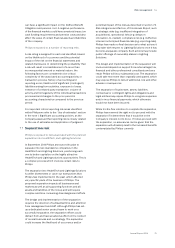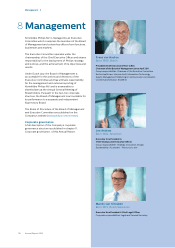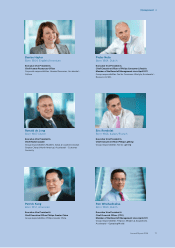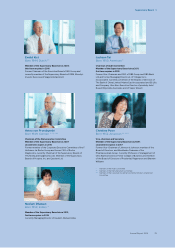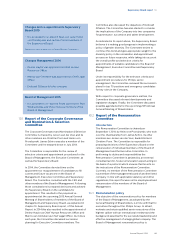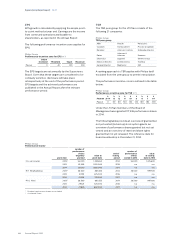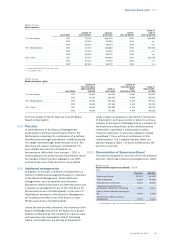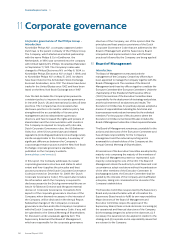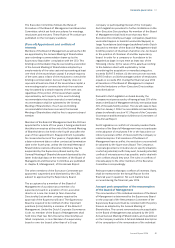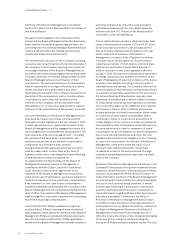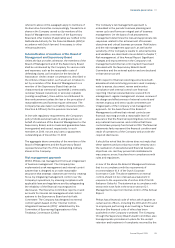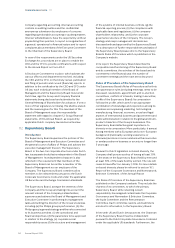Philips 2014 Annual Report Download - page 84
Download and view the complete annual report
Please find page 84 of the 2014 Philips annual report below. You can navigate through the pages in the report by either clicking on the pages listed below, or by using the keyword search tool below to find specific information within the annual report.
Supervisory Board report 10.2.1
84 Annual Report 2014
benchmarked regularly against companies in the
general industry and aims at the median market
position.
One of the goals behind the policy is to focus on
improving the performance of the company and to
enhance the value of the Philips Group. Consequently,
the remuneration package includes a variable part in
the form of an annual cash incentive and a long-term
incentive consisting of performance shares. The policy
does not encourage inappropriate risk-taking.
The performance targets for the members of the Board
of Management are determined annually at the
beginning of the year. The Supervisory Board
determines whether performance conditions have
been met and can adjust the payout of the annual cash
incentive and the long-term incentive grant upward or
downward if the predetermined performance criteria
were to produce an inappropriate result in
extraordinary circumstances. The authority for such
adjustments exists on the basis of contractual ultimum-
remedium and claw-back clauses. In addition, pursuant
to Dutch legislation eective January 1, 2014, incentives
may, under certain circumstances, be amended or
clawed back pursuant to statutory powers. For more
information please refer to chapter 11, Corporate
governance, of this Annual Report. Further information
on the performance targets is given in the chapters on
the Annual Incentive (see sub-section 10.2.6, Annual
Incentive, of this Annual Report) and the Long-Term
Incentive Plan (see sub-section 10.2.7, Long-Term
Incentive Plan, of this Annual Report) respectively.
Key features of our Executive Committee
Compensation Program
The list below highlights Philips’ approach to
remuneration, in particular taking into account
Corporate Governance practices in the Netherlands.
What we do
• We pay for performance
• We conduct scenario analyses
• We have robust stock ownership guidelines
• We have claw-back policies incorporated into our
incentive plans
• We have a simple and transparent remuneration
structure in place
What we do not do
•We do not pay dividend equivalents on stock options
and unvested restricted share or performance share
units
• We do not oer executive contracts with longer than
12 months’ separation payments
• We do not have a remuneration policy in place that
encourages our Board of Management to take any
inappropriate risks or to act in their own interests
• We do not reward failing members of the Board of
Management upon termination of employment
•We do not grant loans or give guarantees to the Board
of Management
10.2.2 Contracts
Below, the main elements of the contracts of the
members of the Board of Management are included.
These contracts expire at the end of the Annual General
Meeting on May 7, 2015. Please refer to sub-section
10.2.11, Year 2015, of this Annual Report at the end of this
section.
Term of appointment
The members of the Board of Management are
appointed for a period of 4 years it being understood
that this period expires no later than at the end of the
following general meeting of shareholders (AGM) held
in the fourth year after the year of appointment.
Philips Group
Contract terms for current members
end of term
F.A. van Houten AGM 2015
R.H. Wirahadiraksa AGM 2015
P.A.J. Nota AGM 2015
Notice period
Termination of the contract by a member of the Board
of Management is subject to three months’ notice. A
notice period of six months will be applicable in the
case of termination by the Company.
Severance payment
The severance payment is set at a maximum of one
year’s salary.
Share ownership
Simultaneously with the introduction of the current LTI
Plan in 2013, the guideline for members of the Board of
Management to hold a certain number of shares in the
Company has been increased to the level of at least
200% of base pay (300% for the CEO). Until this level
has been reached the members of the Board of
Management are required to retain all after-tax shares
derived from any long-term incentive plan.
Both Ron Wirahadiraksa and Pieter Nota have reached
the required level and the CEO has increased his
ownership signicantly throughout the year to currently
70% of his target.
10.2.3 Scenario analysis
The Remuneration Committee conducts a scenario
analysis annually. This includes the calculation of
remuneration under dierent scenarios, whereby
dierent Philips performance assumptions and
corporate actions are examined. The Supervisory Board
concluded that the current policy has proven to
function well in terms of a relationship between the
strategic objectives and the chosen performance
criteria and believes that the Annual and Long-Term
Incentive Plans support this relationship.



